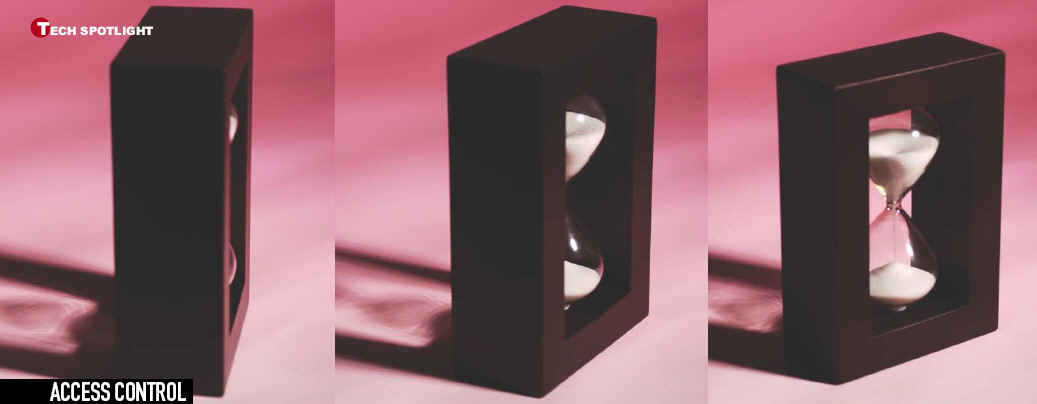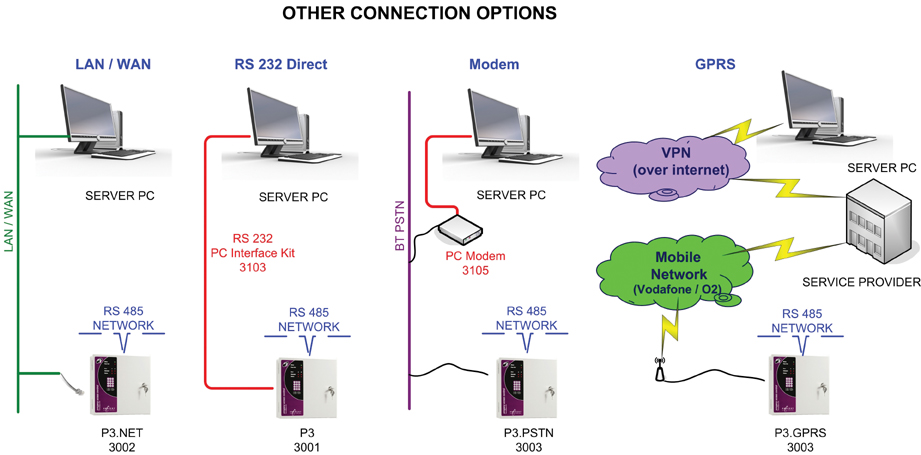By Brett Burby

IP CONNECTIVITY
IP connectivity is especially useful for situations where several remote locations need to be controlled by the same system from a central point using LAN with TCP/IP connections. Cable free General Packet Radio Service (GPRS) management of access via PC, using the existing mobile telephone network, means that the largest organizations can be catered for no matter how many buildings there are or how many thousands of doors need to be included in the system. For example, BSB Electronics’ Progeny range of products offer LAN, WAN, GPRS, USB, and modem RS485 connections -- see figure 1 and 2.
SMS/email messaging to mobiles can be used to alert security staff at any location when there are problems.
Leading-edge systems are also able to support electronic booking of conference halls, sports halls and even shared facilities in multi occupied halls of residence and they can even be used for billing users when they make these bookings!

Figure 1. Connection option USB-485 adaptor (Source: BSB Electronics)

Figure 2. Other connection options (Source: BSB Electronics)
ON-LINE SYSTEMS IN DEMAND
On-line access control systems that use standard operating systems such as Windows XP and Vista are more and more in demand. They typically offer automatic backup arrangements and some, such as BSB Electronics’ Progeny P2 and P3 products, offer the option of using the SQL server database as an alternative to Microsoft’s Access package. Long range Radio Frequency IDentifiers (RFID) technology can offer hands free access control and personnel roll call and even scan multiple tags at any one time
INTEGRATION
Integration with a wide range of software is part of the very exciting developments currently taking place in the access control industry. Integration in this way means that lighting and heating can be controlled; recording who is present in a building is very easily achieved and links to CCTV and fire alarms also extend the usefulness of access control systems. Not only can advanced systems lock doors when required and monitor fire doors, they are able to immobilize lifts and alert adjacent CCTV. This allows security staff to observe the situation and respond quickly. Advanced links to CCTV enable recordings to be triggered and also allow for specific events to be quickly located. Integration with systems managing access to sites by visitors and contractors are useful as are links to time and attendance and payroll systems. Feeding data collected by access control systems through to other software gives added value. There are also health and safety spins offs from access control systems. Because they allow companies to know who is in the building and whereabouts in the building they are, this is very useful information if a roll call is needed for any reason such as a fire alarm going off.
USER FRIENDLY INTERFACES
Unlike conventional locks which can cause problems when keys are lost or stolen and locks need to be changed, with access control systems it is simple to disable proximity readers or swipe cards. And, instead of all the work involved in getting keys cut for new staff, it is easy to add new users or take old users-off the system when staff leaves. Similarly modern systems of access control make it easy to change the areas to which individual users have access. The best systems provide user- friendly interfaces to make using them so much easier. These days, users can expect to see graphics plus the ability to zone areas to suit their particular needs.
Although access control is a technical product, it is a critical system capable, when it goes wrong, of having a huge impact because it may prevent many people from getting into buildings. Consequently the right level of support from manufacturers is crucial. Product reliability backed by readily available, responsive and knowledgeable support from manufacturers is essential.
COPING WITH CHALLENGES
Challenging Environments
Wet or exposed locations are no barrier to modern access control systems. For example, some keyboards and readers are guaranteed to be vandal proof. In fact, BSB offers a money-back guarantee on their vandal proof keyboard and reader. Tough, weatherproof and fire resistant as well, these are ideal for use in any outdoor location including exposed and wet locations. The back lit buttons make it easy to use in the dark and an integral sounder lets users know if the door is open longer than it should be.
Enhanced Security Requirements
Access control is well able to meet the varying demands of users by providing specific features such as the interlocking capability that comes as standard with BSB’s Progeny range of products. Interlock allows two or more doors to work together creating an air lock and allow controlled access through multiple doors -- of great benefit to banks and building societies.
Confidentiality
Concerns about confidentiality are often raised when considering access control systems but again it is possible to address this problem with products specifically designed to prevent covert viewing of keypads. Scrambler keyboards such as those manufactured by BSB offer reduced, narrow viewing angles for the digital read out and the digit buttons are rearranged in random order each time the unit is used, thereby making sure that even the pattern of the keys is unrecognizable from a short distance away.
Disability
Access control designers are also able to take into account the specific needs of disabled people by developing programmable systems that can include variable lock times to suit individual needs compatible with the UK’s Disability Discrimination Act.
LOOKING TO THE FUTURE
Environmental Factors
These days it is essential that we consider ways of reducing our carbon footprint and this applies to the design and manufacture of access control products as much as in any other aspect of life. We should take environmental issues seriously and take into account such factors as low power, product weight and the impact this has on transport costs when we design and manufacture access control products.
Reader Technologies
While keyboards will always have a place in the access control market and proximity and long range RFID reader technologies are currently increasing their share of the market, there is no doubt that biometric systems are where the future lies. It is early days at the moment, but as soon as biometric systems are able to easily and quickly recognize something about a person and can be produced reliably and cheaply, they will take the access control market by storm.
The main challenge is to design and produce reliable, high quality access control systems that are flexible, able to adapt to ever changing requirements, cost-effective and easy to install and manage. In the medium to long term, integrated systems, advanced network systems and asset tagging systems will be the strongest areas of growth in the access control industry.
Brett Burby is Managing Director of UK-based BSB Electronics Ltd. (www.progeny.co.uk).
For more information, please send your e-mails to swm@infothe.com.
ⓒ2007 www.SecurityWorldMag.com. All rights reserved.
|



